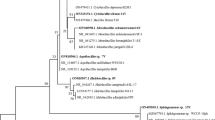Abstract
Crude oil and its derivatives because of different events and accidents may cause pollution to the environment. A biological treatment is a novel technique that uses microorganisms to remove or neutralize pollutants from a contaminated site. Oil-contaminated soils were sampled, after isolating of soil bacteria, using quantitative and qualitative screening, biosurfactant-producing bacteria were identified and environmental factors on the growth of bacteria and biosurfactant were investigated. In this study, the Bacillus subtilis was identified as the best biosurfactant-producing strain which has the ability to grow in environments with high salinity and temperature and pH > 5. The produced biosurfactant from B. subtilis is stable to changes in temperature and salt concentration and pH (in the range of 5–12).The B. subtilis also showed that they are able to biodegrade aliphatic alkanes. The B. subtilis has necessary potential for bioremediation of oil pollution in the environment.





Similar content being viewed by others
References
Abouseoud M, Maachi R, Amrane A, Boudergua S, Nabi A (2008) Evaluation of different carbon and nitrogen sources in production of biosurfactant by Pseudomonas fluorescens. Desalination 223(1):143–151
Bezza FA, Beukes M, Nkhalambayausi Chirwa EM (2015) Application of biosurfactant produced by Ochrobactrum intermedium CN3 for enhancing petroleum sludge bioremediation. Process Biochem 50(11):1911–1922
Bognolo G (1999) Biosurfactants as emulsifying agents for hydrocarbons. Colloids Surf A 152(1):41–52
Carrillo PG, Mardaraz C, Pitta-Alvarez SI, Giulietti AM (1996) Isolation and selection of biosurfactant-producing bacteria. World J Microbiol Biotechnol 12(1):82–84
Cavalero DA, Cooper DG (2003) The effect of medium composition on the structure and physical state of sophorolipids produced by Candida bombicola ATCC 22214. J Biotechnol 103(1):31–41
Cooper DG, Goldenberg B (1987) Surface active agents from two Bacillus species. Appl Environ Microbiol 53(2):224–229
Fisher SH, Sonenshein AL (1991) control of carbon and nitrogen metabolism in Baciluss subtilus. Annu Rev Microbiol 45(1):107–135
Ilori MO, Amobi CJ, Odocha AC (2005) Factors affecting biosurfactant production by oil degrading Aeromonas spp. isolated from a tropical environment. Chemosphere 61(7):985–992
Jain RM, Mody K, Mishra A, Jha B (2012) Physicochemical characterization of biosurfactant and its potential to remove oil from soil and cotton cloth. Carbohydr Polym 89(4):1110–1116
Javaheri M, Jenneman GE, McInerney MJ, Knapp RM (1985) Anaerobic Production of a biosurfactant by Bacillus licheniformis JF-2. Appl Environ Microbiol 50(3):698–700
Khopade A, Biao R, Liu X, Mahadik K, Zhang L, Kokare C (2012) Production and stability studies of the biosurfactant isolated from marine Nocardiopsis sp. B4. Desalination 285:198–204
Makkar RS, Cameotra SS (1998) Production of biosurfactant at mesophilic and thermophilic conditions by a strain of B. subtilis. J Ind Microbiol Biotechnol 20(1):48–52
Margesin R (2000) Potential of cold-adapted microorganisms for bioremediation of oil-polluted Alpine soils. Int Biodeterior Biodegrad 46(1):3–10
Morikawa M, Daido H, Takao T, Murata S, Shimonishi Y, Imanaka T (1993) A new lipopeptide biosurfactant produced by Arthrobacter sp. strain MIS38. J Bacteriol 175(20):6459–6466
Nasr S, Soudi MR, Mehrnia MR, Sarrafzadeh MH (2009) Characterization of novel biosurfactant producing strains of Bacillus spp. isolated from petroleum contaminated soil. Iran J Microbiol 1(2):54–61
Nitschke M, Pastore GM (2006) Production and properties of a surfactant obtained from B.subtilis grown on cassava wastewater. Bioresour Technol 97(2):336–341
Ojo OA (2006) Petroleum-hydrocarbon utilization by native bacterial population from a wastewater canal Southwest Nigeria. Afr J Biotechnol 5(4):333–337
Rahman K, Street G (2002). Bioremediation sludge using bacterial consortium with biosurfactant. Clean Environ Manag-TS13BA, (Environmental Bioremediation Technologies (pp. 391–408). Springer Berlin)
Shahidi Rizi M, Akhavan Sepahi A, Sadat Tabatabaee M (2012) Crude oil biodegradation by a soil indigenous Bacillus sp. isolated from Lavan Island. Bioremediat J 16(4):218–224
Singh A, Van Hamme JD, Ward OP (2007) Surfactants in microbiology and biotechnology: part 2: application aspects. Biotechnol Adv 25(1):99–121
Tian Y, Fanb Y, Liub J, Zhaob X, Chen W (2016) Effect of nitrogen, carbon sources and agitation speed on acetoin production of B.subtilis SF4-3. Electron J Biotechnol 19:41–49
Trindade PVO, Sobral LG, Rizzo ACL, Leite SGF, Soriano AU (2005) Bioremediation of a weathered and a recently oil-contaminated soilsfrom Brazil: a comparison study. Chemosphere 58(4):515–522
Vasileva-Tonkova E, Galabova D (2003) Hydrolytic enzymes and surfactants of bacterial isolates from lubricant-contaminated wastewater. Z Naturforsch. C 58(1–2):87–92
Verma S, Bhargava R, Pruthi V (2006) Oily sludge degradation by bacteria from Ankleshwar, India. Int Biodeterior Biodegrad 57(4):207–213
Xia WJ, Dong HP, Yu L, Yu DF (2011) Comparative study of biosurfactant produced by microorganisms isolated from formation water of petroleum reservoir. Colloids Surf A 392(1):124–130
Youssef NH, Duncan KE, Nagle DP, Savage KN, Knapp RM, McLnerney MJ (2004) Comparison of methods to detect biosurfactant production by diverse microorganisms. J Microbiol Methods 56(3):339–347
Acknowledgements
The authors wish to sincerely thank all who assisted in preparation of this work.
Author information
Authors and Affiliations
Corresponding author
Additional information
Editorial responsibility: M. Abbaspour.
Rights and permissions
About this article
Cite this article
Tabari, K., Tabari, M. Characterization of a biodegrading bacterium, Bacillus subtilis, isolated from oil-contaminated soil. Int. J. Environ. Sci. Technol. 14, 2583–2590 (2017). https://doi.org/10.1007/s13762-017-1313-3
Received:
Revised:
Accepted:
Published:
Issue Date:
DOI: https://doi.org/10.1007/s13762-017-1313-3




